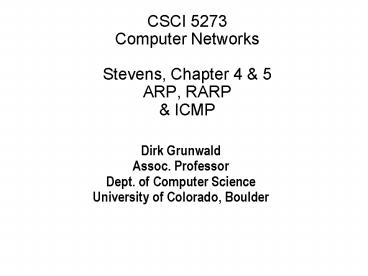CSCI 5273 Computer Networks Stevens, Chapter 4 - PowerPoint PPT Presentation
1 / 21
Title:
CSCI 5273 Computer Networks Stevens, Chapter 4
Description:
RARP is a protocol for 'managing' a machine -- telling a machine what it's IP ... At boot-up, many systems issue an ARP request for their own IP address. ... – PowerPoint PPT presentation
Number of Views:20
Avg rating:3.0/5.0
Title: CSCI 5273 Computer Networks Stevens, Chapter 4
1
CSCI 5273Computer NetworksStevens, Chapter 4
5ARP, RARP ICMP
- Dirk GrunwaldAssoc. ProfessorDept. of Computer
ScienceUniversity of Colorado, Boulder
2
Outline
- ARP is a protocol for mapping and IP address to a
MAC address - RARP is a protocol for managing a machine --
telling a machine what its IP address should be,
based on the MAC address - ICMP is the internet control message protocol and
is used to manage ( measure) many aspects of IP
3
ARP - The Problem
- Once a packet has been routed to a specific
network, we need to deliver it to the appropriate
host - The host Ethernet only listens to an ethernet MAC
address - We only have an IP address
- Thus, we need to know how to map the IP address
to a MAC address
4
ARP - Example
- FTP uses gethostbyname to determine the IP
address of an FTP server - FTP asks TCP to establish a connection
- TCP send a connection request to that IP address,
which is on the local network - The O/S uses ARP to determine the Ethernet MAC
address - The destination O/S replies the reply is
received - The IP layer can now send the packet
5
The sequence
6
Format of an ARP request
HardwareSize
ProtocolType
SizeType
HardwareType
EthenetDest. Address
EthernetSrc Address
SenderEnet Addr
SenderIP Addr
TargetEnet Addr
TargetIP Addr
Notice this!Used by Proxy ARP
7
Notes
- ARP uses a physical (Ethernet) broadcast to the
network - A unicast response is used to inform the sender
of the appropriate MAC address - ARP responses are cache by the kernel
- Everyone listens to the Sender message and caches
that response
8
You can use arp to see the ARP table
- foobar-22 arp -a
- mx6-0.cs.colorado.edu (128.138.241.90) at
00-00-f8-75-4b-38 - cs-gw3-esl.cs.colorado.edu (128.138.241.65) at
00-e0-f7-94-05-80 - ragtop.cs.colorado.edu (128.138.241.81) at
00-00-f8-75-5b-8c - foobar-23
9
Example ARP exchange
Destination MAC
Sender MAC
- 110754.537688 00f80a3f2 ffffffffffff
arp 42 arp who-has ragtop.cs.colorado.edu tell
foobar.cs.colorado.edu - 110754.538665 00f8755b8c 00f80a3f2
arp 60 arp reply ragtop.cs.colorado.edu is-at
00f8755b8c
10
Proxy ARP
- ARP Packets reply to the Sender Hardware
Address and cache the Target Hardware Address - This can be different than the Ethernet Source
Address of the reply! - Thus, host A can reply for host B, and all IP
packets destined for B will be sent to A - Host A can then insure they get to host B
11
Using Proxy ARP
gateway
.1.4
Enet, 140.252.1
.1.183
netb
.1.29
bsdi
sun
192.252.1.183
.13.35
.13.33
Enet, 140.252.13
12
Using ARP to spot configuration problems
- At boot-up, many systems issue an ARP request for
their own IP address. - If anyone responds, something is mis-configured
- You can also use gratituous ARP for rapid
fail-over. - Everyone (usually) snoops the sending hardware
address - Server A B have same internal IP address, but A
is dormant - Server A listens for a death song from Server B
- Server A immediately send an ARP request
- Everyone now thinks that A is the specified IP
address
13
RARP
- RARP is a reverse ARP request
- A host knows its MAC address, but not the
specified IP address - Broadcasts an RARP who-is request
- An RARP server looks up the MAC address in a
table (/etc/ethers) and replys with the IP address
14
Sample /etc/ethers table
- Anchor and clients
- 080020085866 anchor
- 0800200632a0 littletime
- 08002007a5ce chimay
- 08002002b274 duvel
- 08002000e68b alltime
- 080020000c7a pilsner
- 08002002a4c1 white
- 08002001d5a4 twig
15
Implementation of RARP servers
- RARP entries are typically stored in a file
- Rather than implement this as a kernel
process/module, most systems use a (privileged)
daemon - That daemon listens on the interface for all
WHO-IS packets
16
ICMP - Internet Control Message Protocol
- Communicates error and exceptional conditions
- Some ICMP messages cause errors to be returned to
the use process
IPHeader
(contents depend on type code)
8-bit type
Checksum of ICMP
8-bitcode
17
ICMP Types
18
Error Reporting
- ICMP never returns errors (e.g. destination
unreachable) for - ICMP error messages
- A datagram destined for an IP broadcast address
- A datagram sent as a link-layer broadcast
- A fragment other than the first
- A datagram whose source address does not define a
single host (zero, loopback, broadcast or
multicast) - Avoids broadcast storm
- Implies that protocols must be able to deal with
dropped ICMP packets
19
ICMP Destination Unreachable Codes
20
Sample ICMP Types
- ICMP address mask reply informs a host about
the subnet mask that should be used - As stevens points out
- Not reliable (e.g., Unix SVR4 reply was
incorrect) - Alternate protocols exist (e.g. BOOTP DHCP)
21
Sample ICMP Types
- ICMP Timestamp Request Reply
- Used to return the current time from another host
- Could be used for (primitive) time
synchronization protocol, but NTP and XNTP do a
much better job































